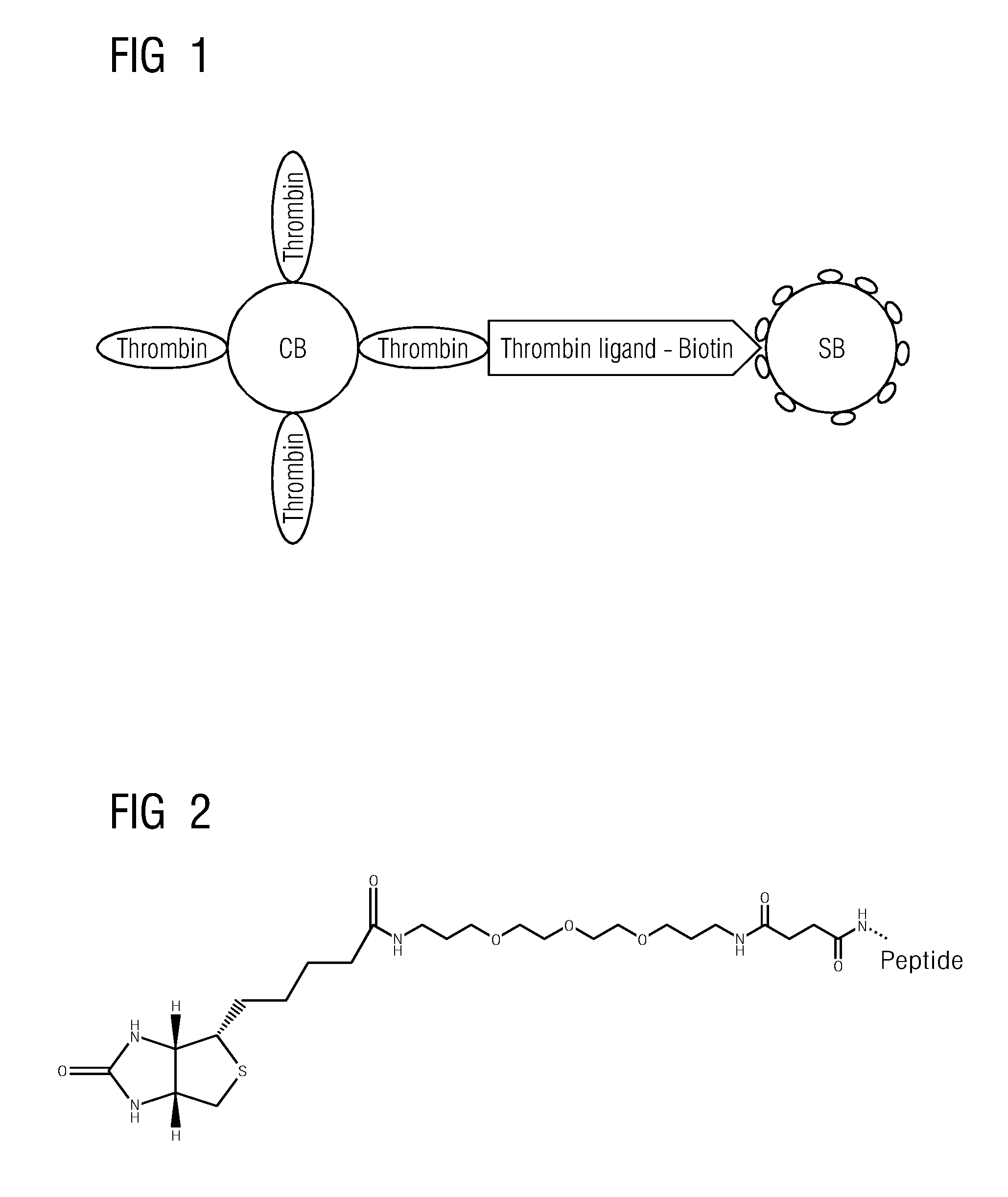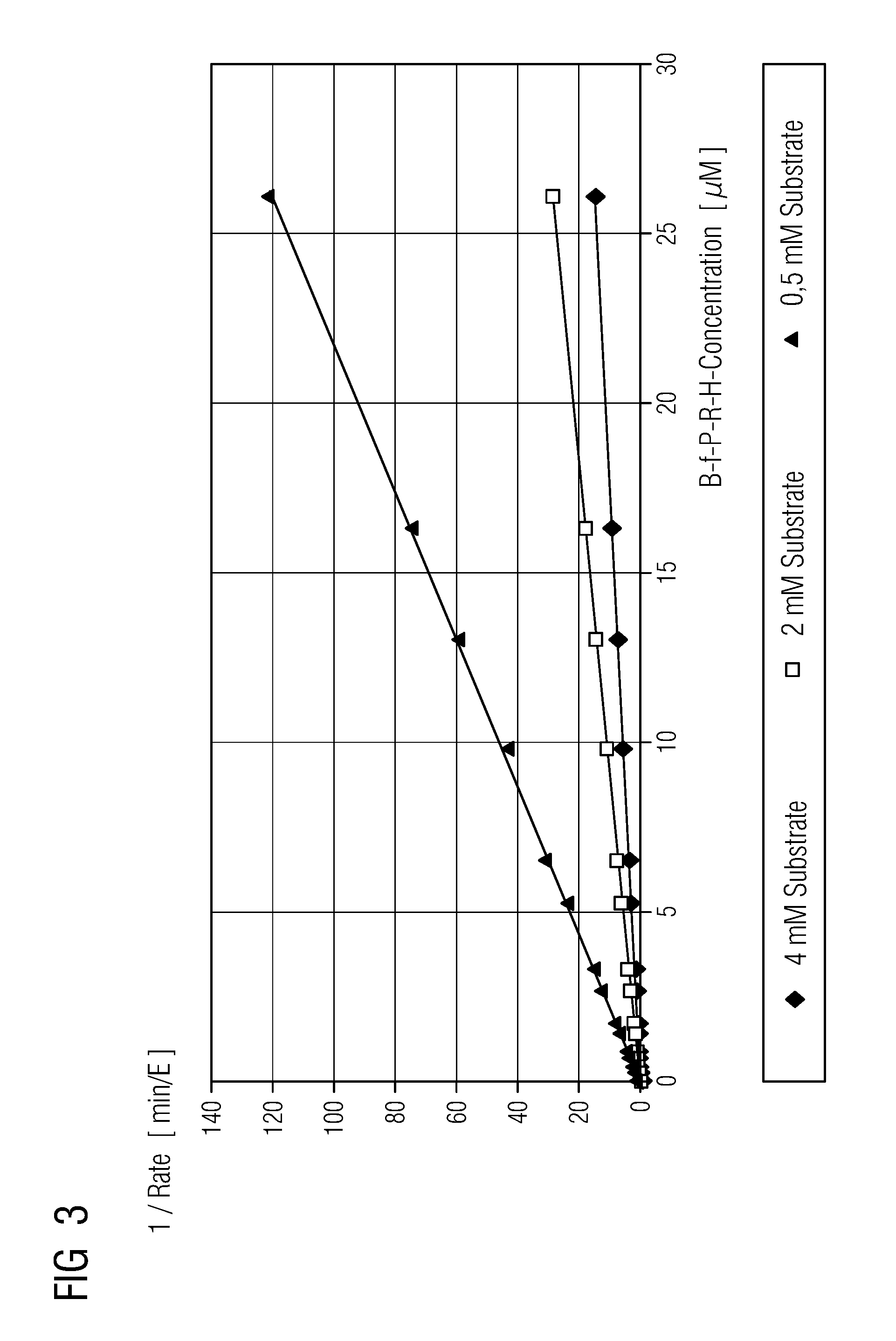Method of determining inhibitors of coagulation
a technology of inhibitors and coagulation, applied in the field of coagulation diagnostics, can solve the problem of complex technical requirements for providing suitable substrate ligands, and achieve the effect of improving light scattering
- Summary
- Abstract
- Description
- Claims
- Application Information
AI Technical Summary
Benefits of technology
Problems solved by technology
Method used
Image
Examples
example 1
Synthesis of Thrombin and Factor Xa biotinyl-Ttds-peptide Aldehyde Ligands
[0148]The peptide aldehydes -D-Phe-Pro-Arg-H (see Claeson, G., Blood Coagulation and Fibrinolysis 5, 1994, page 417) and -D-Arg-Gly-Arg-H (cf. Claeson, G., Blood Coagulation and Fibrinolysis 5, 1994, page 426) were synthesized on a solid phase, extended with a Ttds spacer (Ttds=4,7,10-trioxa-1,13-tridecanediaminosuccinic acid (Bartos, A. et al., 2009, Biopolymers 92(2), 110-115)), and provided with biotin. The compound biotinyl-Ttds-D-Phe-Pro-Arg-H has a molecular weight of 930.15 g / mol and is abbreviated to B-f-P—R—H hereinbelow. The compound biotinyl-Ttds-D-Arg-Gly-Arg-H has a molecular weight of 899.10 g / mol and is abbreviated to B-r-G-R—H hereinbelow. The peptide aldehydes were removed from the solid phase with trifluoroacetic acid. The compounds were stored at −20° C. in a lyophilized form. The structure of the biotin linker is depicted in FIG. 2.
example 2
Determination of the Thrombin Binding Constants of the Peptide Aldehyde Ligands
[0149]The kinetic data of the peptide aldehyde ligands were determined in chromogenic assay formats by measuring the rate of hydrolysis of chromogenic peptide substrates which compete with the peptide aldehyde ligands for binding to the active site of the particular enzyme, at various substrate concentrations and peptide aldehyde-ligand concentrations. The binding constant (Ki) was determined by a known method (Dixon, M., 1953, Biochem J, 55, 170-171).
[0150]The thrombin binding constant was determined using the reagents of the hirudin activity assay from Siemens Healthcare Diagnostics. The hirudin activity assay comprises a lyophilized thrombin reagent consisting of bovine thrombin, a heparin inhibitor and aprotinin, a lyophilized chromogenic substrate reagent with a concentration of 4 mmol / l tos-Gly-Pro-Arg-ANBA-IPA (tosylglycyl-L-propyl-arginyl-5-amino-2-nitrobenzoyliso-propylamide) after reconstitution...
example 3
Determination of the F Xa Binding Constants of the Peptide Aldehyde Ligands
[0162]The F Xa binding constant was determined using the reagents of the Berichrom® heparin assay from Siemens Healthcare Diagnostics. The Berichrom® heparin assay consists of:
an F Xa reagent consisting of a lyophilized plasma fraction containing factor Xa, and additives such as Tris, NaCl, EDTA and preservatives,
a chromogenic substrate reagent (Z-D-Leu-Gly-Arg-ANBA-methyl-amide),
a dilution reagent for reconstitution, and
a dextran sulfate reagent consisting of lyophilized dextran sulfate.
[0163]After reconstitution in 10 ml of dilution reagent, the dextran sulfate concentration is 0.02 g / l. The F Xa reagent is reconstituted with the reconstituted dextran sulfate reagent. The substrate reagent, after constitution with 2 ml of deionized water, contains 4 mmol / l Z-D-Leu-Gly-Arg-ANBA-methyl-amide. Dilutions of the substrate reagent were prepared with deionized water. The peptide aldehyde ligands prepared according...
PUM
| Property | Measurement | Unit |
|---|---|---|
| diameter | aaaaa | aaaaa |
| diameter | aaaaa | aaaaa |
| diameter | aaaaa | aaaaa |
Abstract
Description
Claims
Application Information
 Login to View More
Login to View More - R&D
- Intellectual Property
- Life Sciences
- Materials
- Tech Scout
- Unparalleled Data Quality
- Higher Quality Content
- 60% Fewer Hallucinations
Browse by: Latest US Patents, China's latest patents, Technical Efficacy Thesaurus, Application Domain, Technology Topic, Popular Technical Reports.
© 2025 PatSnap. All rights reserved.Legal|Privacy policy|Modern Slavery Act Transparency Statement|Sitemap|About US| Contact US: help@patsnap.com



